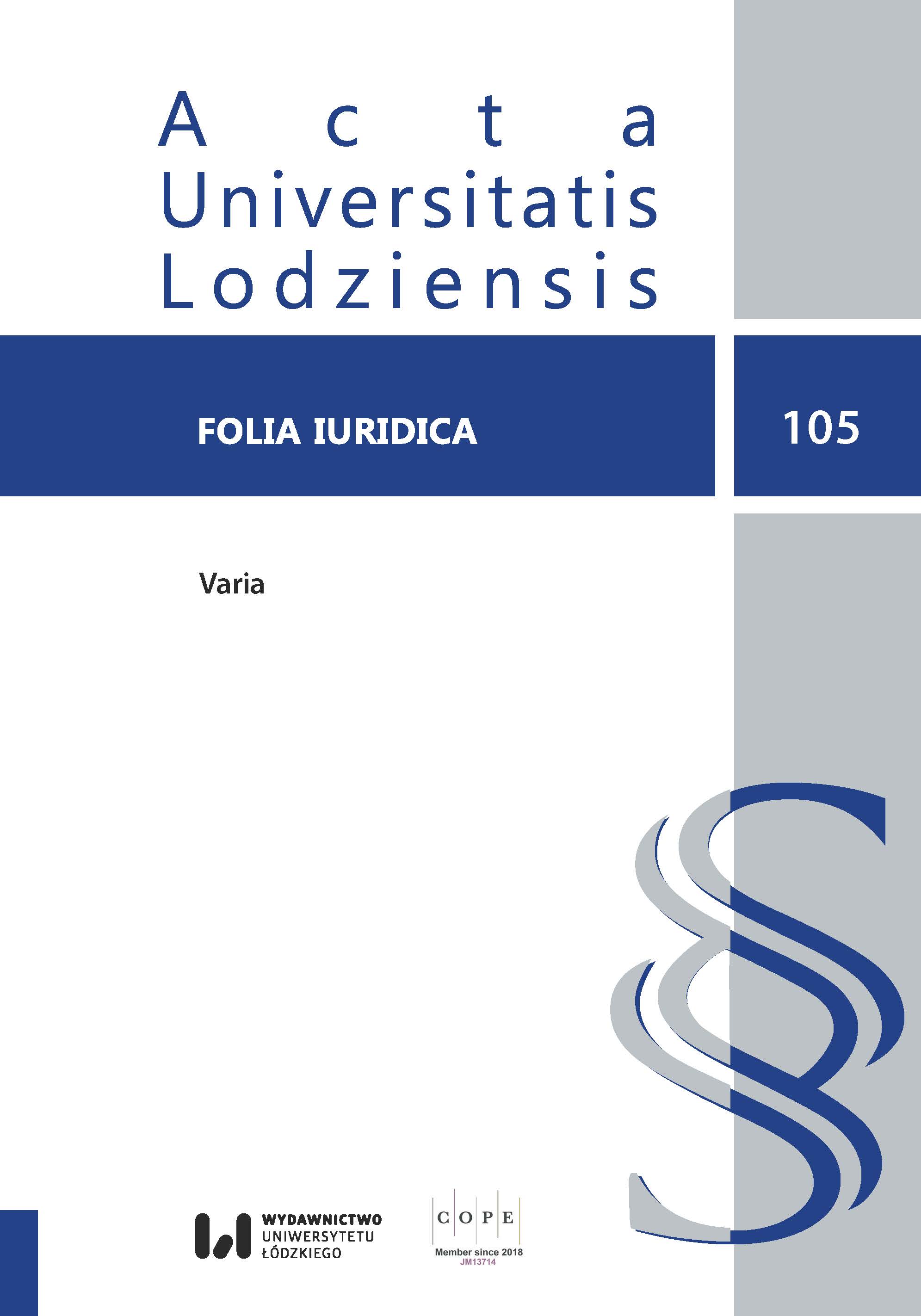From Maternal Preference to Shared Parenting: Child’s Well-Being. Lessons from the USA
DOI:
https://doi.org/10.18778/0208-6069.105.12Keywords:
divorce, separation, custody, parenting, child's welfareAbstract
The article concerns parenting after divorce or separation within the context of social changes. Special attention is paid to the principle of the welfare of the child, which is the most important criterion for deciding child custody. The child’s welfare is an open concept that grants a wide discretion to courts in choosing the best custodial arrangement for a child in a particular case. In this context, reference was made to the American experience on parenting after family break-up, separation or divorce. In the USA different theories were developed to explain which parenting model best fulfils the principle of the child’s welfare. This article discusses the tender years doctrine, primary care-taker preference, psychological parent doctrine and approximation rule. After a divorce, a mother was usually granted custody and a father paid child-support. He was placed in the background and excluded from the daily activities of his child. Currently, the theory of mother-nurturer and father-breadwinner is coming to an end; the father is no longer the only breadwinner responsible for providing the family an adequate standard for living, and the mother is no longer primarily responsible for the duties of childrearing and household chores. The changes taking place are reflected in struggling for equal treatment in the award of custody and abandoning the stereotypical approaches based on awarding custody automatically to mothers. A significant rise in the number of parents entering into joint custody arrangements is observed.
Downloads
References
Atwell, Anthony E. Ursula S. Moore. Evan Nielsen. Ziva Levite. 1984. “Effects of Joint Custody on Children.” The Journal of the American Academy of Psychiatry and the Law 12(2): 149–157.
Google Scholar
Bratt, Carolyn. S. 1978–1979. “Joint Custody.” Kentucky Law Journal 67(2): 271–308.
Google Scholar
Bratton, Robert M. 1981. “Joint Custody in Kentucky.” Northern Kentucky Law Review 8(3): 553–576.
Google Scholar
DiFonzo, Herbie J. 2015. “Dilemmas of Shared Parenting in the 21st Century: How Law and Culture Shape Child Custody.” Hofstra Law Review 43(4): 1003–1024.
Google Scholar
Forman, Deborah L. 2019. “Legal Relationships Between Adults and Children in the United States of America.” In Adults and Children in Postmodern Societies. A Comparative Law and Multidisciplinary Handbook. Edited by Jehanne Sosson, Geoffrey Willems, Gwendoline Motte. 583–622. Cambridge: Intersentia. https://doi.org/10.1017/9781780688480.021
Google Scholar
Goldstein, Joseph. Anna Freud. Albert J. Solnit. 1979. Beyond the Best Interests of the Child (New Edition with Epilogue). New York: Free Press.
Google Scholar
Hawkins, Lois E. 1982. “Joint Custody in Louisiana.” Louisiana Law Review 43(1): 85–118.
Google Scholar
Kurki-Suonio, Kirsti. 2000. “Joint Custody as an Interpretation of the Best Interests of the Child in Critical and Comparative Perspective.” International Journal of Law, Policy and the Family 14(3): 183–205. https://doi.org/10.1093/lawfam/14.3.183
Google Scholar
Lapsatis, Nicole. 2012. “In the Best Interests of No One: How New York’s Best Interests of the Child Violates Parents’ Fundamental Right to the Care, Custody, and Control of Their Children.” St. John’s Law Review 86(2 & 3): 673–714.
Google Scholar
Mason, Mary A. Ann Quirk. 1997. “Are Mothers Losing Custody – Read My Lips: Trends in Judicial Decision-making in Custody Disputes – 1920, 1960, 1990, and 1995.” Family Law Quarterly 31(2): 215–236.
Google Scholar
McCall, Shawn. 2019. “Bringing Specificity to Child Custody Provisions in California.” Golden Gate University Law Review 49(2): 141–168.
Google Scholar
Miller, David J. 1979. “Joint Custody.” Family Law Quarterly 13(3): 345–412.
Google Scholar
Mnookin. Robert. 2014. “Child Custody Revisited.” Law and Contemporary Problems 77(1): 249– 274.
Google Scholar
Nielsen, Linda. 2015. “Shared Physical Custody: Does It Benefit Most Children?” Journal of the American Academy of Matrimonial Lawyers 28(1): 79–138.
Google Scholar
Opie, Anne. 1993. “Ideologies of Joint Custody.” Family and Conciliation Courts Review 31(3): 313–326. https://doi.org/10.1111/j.174-1617.1993.tb00307.x
Google Scholar
Sanders, Molly. 2010. “Should Child Custody Awards Be Based on Past Caretaking: The Effect of the Approximation Standard Ten Years after Its Adoption.” Children’s Legal Rights Journal 30(3): 17–35.
Google Scholar
Schrama, Wendy M. 2009. “Family Function over Family Form in the Law on Parentage. The Legal Position of Children Born in Informal Relationships.” In Debates in Family Law around the Globe at the Dawn of the 21st Century. Edited by Katharina Boele-Woelki. 123–144. Antwerp: Intersentia.
Google Scholar
Scott, Elizabeth S. 1992. “Pluralism, Paternal Preference, and Child Custody.” Columbia Law School 80: 615–672. https://doi.org/10.2307/3480710
Google Scholar
Steinbach, Anja. Lara Augustijn. Gerrit Corkadi. 2020. “Joint Physical Custody and Adolescent’s Life Satisfaction in 37 North American and European Countries.” Family Process: 1–14. https://doi.org/10.1111/famp.12536
Google Scholar
Sünderhauf, Hildegund. 2013. “Vorurteile gegen das Wechselmodell: Was stimmt, was nicht? – Argumente in der Rechtsprechung und Erkenntnisse aus der psychologischen Forschung.” FamRB-Beratungspraxis. Aktuelle Praxisfragen 9: 290–335.
Google Scholar
Trout, Linda. 1984. “Missouri Joint Custody Law.” UMKC Law Review 52(4): 625–640.
Google Scholar
Published
Versions
- 2024-02-15 (2)
- 2023-12-22 (1)
How to Cite
Issue
Section
License

This work is licensed under a Creative Commons Attribution-NonCommercial-NoDerivatives 4.0 International License.
Funding data
-
Narodowe Centrum Nauki
Grant numbers DEC-2019/33/N/HS5/00284














